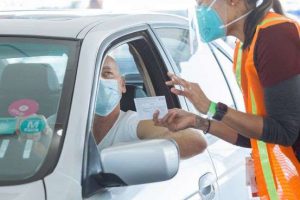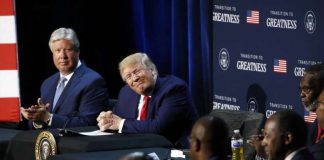MARCH 13, 2021

President Biden’s direction to states to make all adults eligible for coronavirus vaccines by May 1 will pressure governors and local officials to increase the pace of their rollouts, as the U.S. surpassed 100 million vaccinations on Friday.
The milestone comes as the inoculation drive gains pace in the U.S. and as new cases of Covid-19 have dropped in recent weeks. The Centers for Disease Control and Prevention’s data-tracker website showed Friday that some 101 million doses of the three vaccines approved for use in the U.S. have been administered so far.
Mr. Biden’s plan is the strongest sign yet that the Biden administration is confident that the current scarcity of shots will ease in the coming weeks. But getting the U.S. to the stage where most individuals will be able to gather in small groups by July 4, a goal championed Thursday by Mr. Biden, will face challenges.
The U.S. must find enough health workers to give out the shots and create more mass vaccination sites. Officials must work to ensure underserved communities receive the vaccine and hesitancy to take the vaccines is overcome. States will have to step up to the task even though some are still struggling with crashing appointment websites.
“We will have to dramatically increase our capacity, because we are not at that capacity now,” New York Gov. Andrew Cuomo said during a press conference on Friday about reaching the May 1 goal.
For Mr. Biden, there is a political risk that the public will view the May 1 goal as an expectation they will get the vaccine by then—rather than merely being eligible by then—as vaccinations are likely to continue throughout the summer.
“The vaccine won’t be in people’s arms May 1, but it will be available,” said Michael Osterholm, a University of Minnesota disease specialist who advised the Biden transition team on Covid-19. “One of my biggest fears is having enough vaccines but not having people who will take it.”
The administration can legally compel states to make all adults eligible by a given date because the vaccines were approved by the Food and Drug Administration under an emergency use authorization that allows the agency to release treatments in a declared emergency, said Nicholas Bagley, a University of Michigan law professor.
Because of the authorization, the Biden administration has wide discretion to establish conditions governing who should get the vaccines, he said.
“The administration has the authority to be more prescriptive if it would like,” Mr. Bagley said.
In recent days, the U.S. has been administering over 2 million doses a day. The shot made by Pfizer Inc. and BioNTech SE has been administered most frequently in the U.S., with over 50.9 million doses given so far, according to data from the CDC, while Moderna Inc.’s vaccine has been given over 49.1 million times. The single-dose shot made by Johnson & Johnson has been administered over 870,000 times.
Mr. Biden announced plans this week to secure an additional 100 million doses of the J&J vaccine, doubling the company’s commitment. The administration has contracts with Pfizer and Moderna to provide 600 million doses of their two-shot vaccines.
The White House said Friday it would expand the number of people qualified to administer vaccines across the country. Newly eligible vaccinators will include dentists, veterinarians, emergency medical technicians and students in professional healthcare fields, among other personnel.
The Biden administration also said it would make the vaccine available at more than 20,000 pharmacies across the country as part of its federal pharmacy program, and more than double the number of federally-supported mass vaccination sites. The administration will also launch a new website and a call center to help the public better locate where vaccine supply is available.
Mr. Biden has moved quickly to allocate funding from a $1.9 trillion coronavirus relief package, which was passed by Democrats on a party-line vote and signed into law by the president on Thursday. That legislation provides $7.5 billion for vaccine distribution, $48 billion for testing and contact-tracing efforts and more than $160 billion for schools and universities. The White House said the Department of Health and Human Services would immediately dedicate $650 million toward expanding testing for teachers, staff and students in K-8 schools to help them reopen.
“This law is not the end of our efforts, though. In my view, it’s just the beginning,” Mr. Biden said Friday at a White House ceremony with congressional leaders to celebrate the relief bill.
The administration has steadily increased weekly shipments to states amid overwhelming demand. The White House said the weekly doses going out to states, tribes, territories and pharmacies is now at more than 20 million.
“Supply is the main issue right now,” said Ajay Sethi, an associate professor and epidemiologist at the University of Wisconsin-Madison, who said states can open eligibility to the next priority groups as supplies increase, eventually including everybody. “In Wisconsin, vaccinators are operating well below their capacity and continue to receive far fewer doses than requested.”
The different eligibility rules have caused some confusion, and allowed others to game the system. Right now, with various priority rankings, many states have struggled to verify if people are eligible.
This week New Yorkers aged 60 and older became eligible for vaccinations, while in neighboring New Jersey, residents 65 and older are eligible. Over in Connecticut, the lowest age has been set to 55.
Alaska has already made vaccines available to all adults. And Michigan said Friday that all residents aged 16 and up will be eligible for the vaccine beginning April 5, although health officials noted it may take several weeks for everyone who wants a vaccine to get an appointment. The Biden administration said it would establish a federally supported mass vaccination site in Detroit capable of administering 6,000 shots a day.
A number of state leaders, including Georgia Republican Gov. Brian Kemp and Connecticut Democratic Gov. Ned Lamont, said this week that they support the May 1 eligibility change.
The increase in vaccine quantity will so improve the current situation that it shouldn’t make it harder for high-risk people to get the shots if they are competing against the broad public on or after May 1, said Leana Wen, a health policy professor at George Washington University.
“The Biden administration must be very confident in the supply chain and ability to ramp up distribution,” she said.
The administration also said mobile units will be deployed to help get the vaccine to people in rural or other medically underserved areas.
States weren’t briefed in advance before Mr. Biden announced plans to open eligibility by May 1, said Marcus Plescia, chief medical officer at the Association of State and Territorial Health Officials, which represents public health agencies. He said there is a risk that opening up vaccines to all adults could overwhelm the system and make it harder to help underserved communities get doses.
“We probably are going to see some inequity,” he said. “First come, first serve is not a good recipe for equity.”
With vaccine supply on the upswing, some public-health leaders said the biggest concern is getting enough people to get the vaccine so the U.S. can achieve herd immunity by the fall.
“Biden set a clear goal and that’s really reassuring,” Ms. Wen said. “My biggest concern is we’re not going to reach herd immunity by the fall because of complacency.”
Courtesy/Source: WSJ










































































































